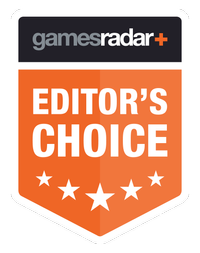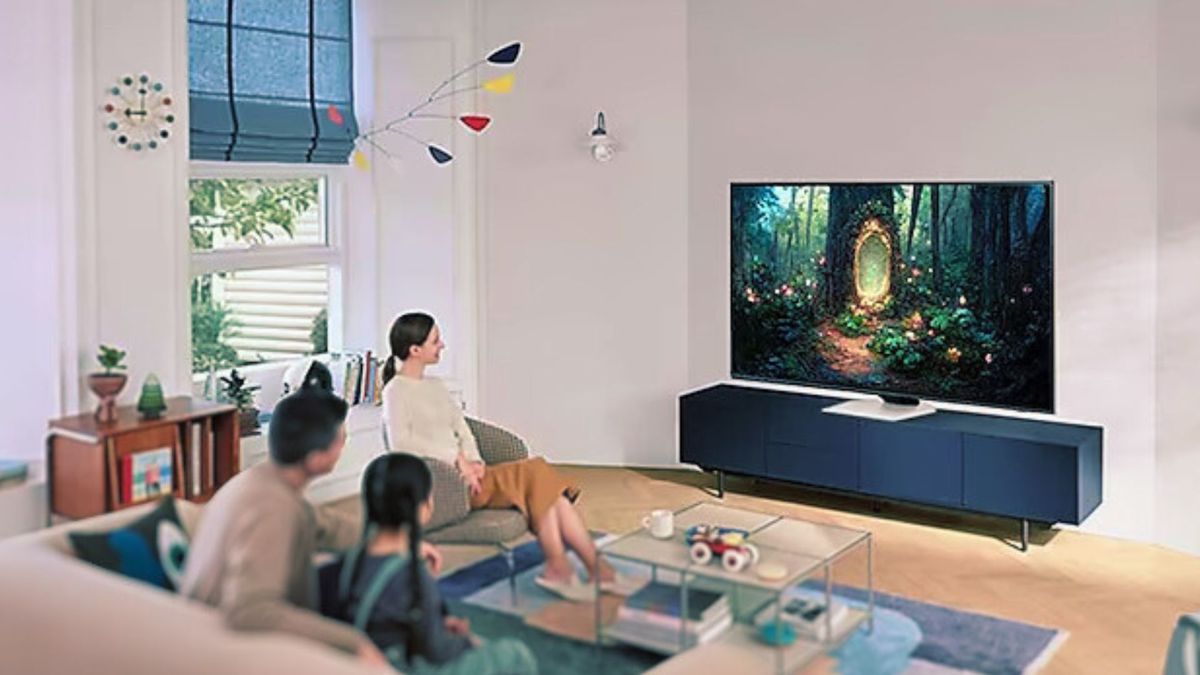12DOVE Verdict
Samsung’s entry-level Mini LED-backlit Neo QLED model is a brilliant combination of game-friendly features and formidable performance. It’s a surprisingly convincing reason not to migrate to OLED.
Pros
- +
Mini LED backlight
- +
Gaming Hub
- +
4k 120 FPS HDMI inputs
Cons
- -
AI Intelligent mode is not so smart
- -
No Dolby Vision
Why you can trust 12DOVE
The Samsung QN85C is a sophisticated Neo QLED screen that uses a Mini LED backlight. More effective than a traditional full array, Mini LED delivers higher HDR peak brightness and far better black level precision, thanks to intelligently controlled clusters of multiple tiny LEDs.
The big surprise is just how good this set’s black-level performance is. It's not all that common for even the best QLED TVs to close the gap on OLED, which until now has had a monopoly on true black. Mini LED also happens to be immune from image retention, which is another tick in the win column.
Picture and sound are governed by Samsung’s 4k Neural Quantum processor, which utilizes AI and Machine Learning techniques, to varying degrees of success. All four HDMI inputs are 4k 120Hz capable, with VRR (Variable Refresh Rate) support and a Gaming Hub and UI which keeps everything of interest in one place.
If you weren't sold already, perhaps the best news is the price, which is competitive for such a high-spec screen. This is a sure-fire contender for the best gaming TV.
Samsung QN85C Price & Availability
Available now, the QN85C comes in 55-, 65-, 75- and 85-inch screen sizes (55QN85C, 65QN85C, 75QN85C, and QN85C) priced at it’ll cost $1499, $1999, $2499, and $3799
I’m testing the 65-inch model here.
Also available in the UK in the same screen sizes, it'll cost £1,599, £2,099, £3,599, and £4,699 respectively. Australian buyers will find the same 55, 65, 77, and 83 inch models priced AUS$2,199, AUS$2,799, AUS$3,299 and AUS$4,499 respectively.
Design and Features
The QN85C looks smart, but admittedly does pay a toll for its backlight technology, having a depth of 28mm depth. The silver-grey bezel is predictably thin though, with a small Samsung badge placed bottom right of the screen. The panel sits on a static, central stand, which makes it very easy to accommodate on regular AV furniture if you’re not wall-mounting.
Around the back are four HDMI inputs. All support 4k 120HZ sources, with HDMI 3 eARC enabled. Given that many rival sets still only offer two 4k 120HZ capable inputs (including Sony, Philips, and Panasonic) this is a big selling point. The QN85C is also AMD Freesync Premium Pro and NVIDIA G-Sync compatible, making it a viable display if you want to hook up one of the best gaming PCs.


Additional connectivity includes an optical digital output, Ethernet, two USB ports, and a CI card slot. There’s a choice of both terrestrial aerial or satellite dish feed. Wireless connectivity covers Bluetooth and dual-band Wi-Fi.
Closer inspection of the rear panel also reveals speakers top left and right, for Samsung’s Object Tracking Sound system. These join side and downward-firing drivers and effectively create a six-channel wall of sound. The TV comes with two remote controls: a simplified, more stylish controller and a traditional zapper. Both have dedicated buttons for Netflix, Prime Video, Samsung TV Plus, and Disney+.
These shortcuts are just the tip of the streaming iceberg. Samsung’s Tizen smart platform is extremely well served with premium VoD and Catch-up apps, including BBC iPlayer, ITVx, Disney+, Apple TV+, YouTube, All Four, MyFive, and Samsung TV Plus. The latter is Samsung’s own channel bouquet of FAST (Free Advertising Supported TV) channels.
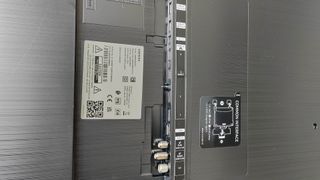
The Tizen home page features a horizontal scrolling bar that populates with your chosen services. Below are curated content recommendations and other viewing options. I found it very easy to operate. Off to the right is a vertical menu for Search, Ambient options, Game, and Media playback.
Of particular interest in all this is a dedicated Gaming Hub, which gathers together cloud gaming services, including Xbox, Utomik, and Twitch, alongside your connected consoles. This minimizes the amount of menu diving you need to do, making it an enthusiast's pick for the best TV for PS5. There’s also a pop-up gaming interface that collects together key settings, like input lag, VRR, and HDR status.
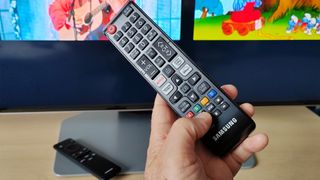
Samsung QN85C: Performance
I was expecting a lot from the Samsung QN85C in terms of performance. I got even more.
Samsung’s Quantum Mini LED backlight execution here is nothing short of a revelation. The QN85C manages to avoid uneven halos and even delivers a convincing black level in letterbox movie bars.
As this is the cheapest Mini LED in Samsung’s Neo QLED I feared it wouldn’t have the same level of HDR snap found higher up the Neo QLED range. While it’s certainly not as bright as its stablemates, it still packs a punch, with a bright average picture level.
When setting up HDR on my PS5, I actually winced at the full-field white. Thankfully, with real-world footage, the balance becomes far more approachable. Peak HDR brightness was measured at just under 1100 nits with a 10 percent measurement window. This means peak HDR highlights are largely delivered without compromise, giving images real dimensional depth.
The caveat is there’s no support for Dolby Vision, which if you’re a movie lover could be a deal breaker. Given that most of the content I watch on Netflix and Disney+ is Dolby Vision encoded, I can’t help feeling I’m missing out. Obviously, this impacts Dolby Vision-encoded games as well.


What we do get is HDR 10 and HDR10+, as favored by Prime Video. Local dimming is variable, but for the best contrast, I opted for Low. Naturally, the set triggers Game mode when a console is connected, but you might want to activate HDR in the Game Picture Expert settings to prevent the picture from looking overly bright.
At the heart of the QN85C’s picture performance is Samsung’s latest Neural Quantum Processor 4K. This silicon takes advantage of AI and neural networks to optimize images on a scene-by-scene basis. You can leave the TV on Intelligent Picture mode, and it’ll manage brightness, contrast, and detail, adjusting for the content type. For most viewers, this is a pain-free route to consistent performance - but there is a caveat when it comes to audio performance (more anon).
There are of course more traditional image presets also available, including Standard, Eco, Movie, Filmmaker mode, and Dynamic. I generally left the set on Standard, as it looked consistently good. The Dynamic mode predictably oversaturates reds and blues, although whites really pop (which could be good for anime, potentially).
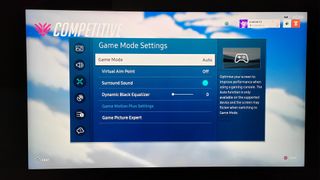
When it comes to overall picture level brightness, I noted a significant difference between Standard and Eco settings. The former makes good use of the set’s native luminosity, while Eco is far more in line with Movie and Filmmaker modes, albeit without their color temperature bias.
The QN85C is bright enough for gaming and general viewing in a brightly lit room but also avoids that insipid greyness that can cloud an LED set when the lighting goes down. The TV comes into its own as a gaming display. 120FPS gameplay is as smooth and detailed as the very best 120Hz 4K TVs.
Samsung actually offers two Game settings, one with most settings disabled, and another which reinstates some processing to maximize picture quality. With the latter, dubbed Game Motion Plus, input lag was measured at a tardy 25ms. If you opt for the more pure approach of the default Game mode, this drops to an impressive 9.4ms (1080/60). There are also Virtual Game Point crosshairs should you need them, and Minimap Zoom.
That OTS speaker configuration copes well when things get busy - even with chaotic FPS action. There’s no shortage of volume, thanks to 60W of amplification. The set is also compatible with Samsung Q-Symphony soundbars. When partnered, the set’s own speakers work in tandem with those in the Q-Symphony soundbar, and the results can be quite impressive.
I reckon the distributed audio of Samsung’s OTS sound system is good enough to defer any immediate investment in one of the best gaming sound systems. There’s a good deal of sound steerage, and it's suitably immersive with Dolby Atmos movies and cinematic TV shows (the soundstage is tall and wide).
However, while I could live with the QN85C’s Intelligent Mode for video, I was less impressed with how AI managed audio. I found the Intelligent audio mode overly dialogue focused, and the Amplify setting is really harsh. My advice is to stick with regular audio settings.
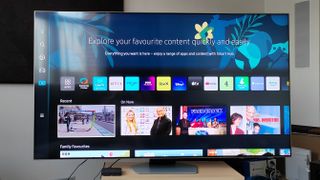
Should you buy the Samsung QN85C?
The 65-inch Samsung QN85C is a great proposition for both gamers and movie fans. It manages that rare feat of delivering on both fronts, with a fully loaded HDMI input board that doesn’t limit 4K 120HZ playback and a dynamic HDR performance that rewards movie fans.
The lack of Dolby Vision is an obvious omission, but at least the QN85C’s peak HDR potential goes a long way to mitigating any onerous tone mapping. Excellent color fidelity and bright room pizzazz are the icing on the cake.
I also really like the Tizen smart platform. It’s intuitive and powerful. All the key streaming apps are readily available and the provision of that Gaming Hub, which groups together cloud services and connected services is pretty cool too.
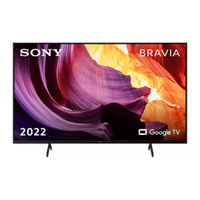
Cheaper alternative
At around two grand for a 65-inch screen, the QN85C can be considered strong value for money, but if you’d rather upgrade your image with something a little less rich, consider the Sony KD65X80. This 4K LED mid-ranger sells for half the price and uses the Google TV platform. You won’t find 4k 120HZ support at this price point, but 4k 60HZ games pop, thanks to Sony’s wide band Triluminos Pro color performance.
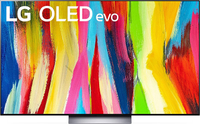
Same price alternative
If you want to consider a direct rival, then weigh up the 65-inch LG G2. This high-end Gallery class EVO OLED is now available at a considerable cost saving, as stock is cleared for the more expensive LG G3. It has four HDMI inputs which support 4k 120 fps sources, plus jaw-dropping image quality.
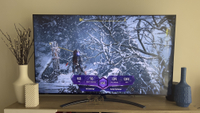
More expensive alternative
If you fancy looking upmarket, then consider LG’s upcoming QNED91. This also uses a high-precision Mini LED backlight and has a similar raft of gaming features, with a quartet of HDMI 2.1 ports, but is built upon the latest iteration of the brand’s celebrated webOS smart platform.
How we tested the Samsung QN85C
As the entry-level Mini LED screen in the Samsung 2023 range, we took a long look at the impact of the set’s backlighting tech. The TV’s HDR performance was measured using industry-standard test patches at both 5 and 10 percent sizes, and picture quality was assessed in both bright and dark room environments with a variety of sources, including UHD Blu-ray, 4K media streamers, and consoles.
Samsung’s Tizen smart platform was checked for smart app compliance and catch-up TV support.
Finally, the screen’s built-in sound system was evaluated with Dolby Atmos test clips, and content streamed from Netflix and Disney+.
Prefer a desktop gaming display? Check out the best gaming monitors, the best 4K monitors for gaming, and the best monitor for PS5.
Steve May is a home entertainment technology specialist. Creator of Home Cinema Choice magazine, Steve writes about gadgets and gizmos for GamesRadar, T3, Louder Sound, TechRadar, Home Cinema Choice and Yahoo. He’s also the editor of The Luxe Review and Pro AV site Inside CI. Steve once wrote a games column for legendary British comic 2000AD (and has a badge to prove it), and maintains that when it comes to top shooters, Doom is the GOAT.

Metaphor: ReFantazio wanted to fix the JRPG grinding problem, but Atlus went too far at one point and accidentally broke the whole combat system

Final Fantasy 7 Remake and Rebirth battle director says combining everything he learned on Monster Hunter: World with Square Enix's technology and unique skills created a "chemical reaction"

"Minutes after Palworld released," Pocketpair was already getting game pitches from "some really big names" before it even set up its own publisher: "No one has money at the moment"
